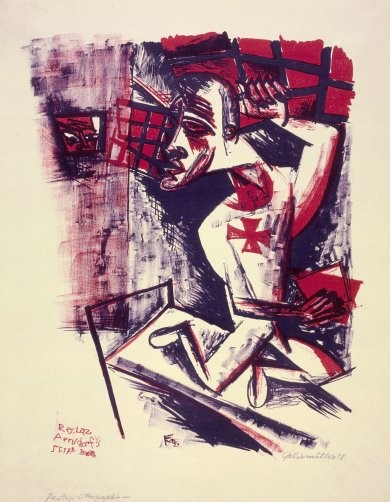Between Art and Politics: Hans Richter’s Germany
23 Mar - 11 Aug 2013

Conrad Felixmüller
Soldier in a Madhouse (Soldat im Irrenhaus), 1918
Lithograph printed in red and blue-violet on laid paper. The Robert Gore Rifkind Center for German Expressionist Studies.
Soldier in a Madhouse (Soldat im Irrenhaus), 1918
Lithograph printed in red and blue-violet on laid paper. The Robert Gore Rifkind Center for German Expressionist Studies.
BETWEEN ART AND POLITICS: HANS RICHTER’S GERMANY
23 March – 11 August 2013
This exhibition focuses on the interaction of political and aesthetic movements in Germany from the 1910s to the early 1920s, and the influence such movements had on the artistic development of Hans Richter (1888–1976); it complements Hans Richter: Encounters, on view in the Resnick Pavilion, May 5–September 2, 2013.
The works of Paul Cézanne, Franz Marc, Wassily Kandinsky, and Oskar Kokoschka exposed the young Hans Richter to the full range of contemporary art from Expressionism to abstraction. Gallerists, writers, and editors of influential cultural and political magazines introduced new artistic movements such as Futurism and Cubism to the German art world and promoted the work of aspiring artists, including Richter. World War I put a stop to this cultural activity and exchange. The exhibition also explores how Richter and many of his fellow artists became politically involved during and after the war, and how they consequently expressed in their work a yearning for a new social order, presaged by new forms of art.
23 March – 11 August 2013
This exhibition focuses on the interaction of political and aesthetic movements in Germany from the 1910s to the early 1920s, and the influence such movements had on the artistic development of Hans Richter (1888–1976); it complements Hans Richter: Encounters, on view in the Resnick Pavilion, May 5–September 2, 2013.
The works of Paul Cézanne, Franz Marc, Wassily Kandinsky, and Oskar Kokoschka exposed the young Hans Richter to the full range of contemporary art from Expressionism to abstraction. Gallerists, writers, and editors of influential cultural and political magazines introduced new artistic movements such as Futurism and Cubism to the German art world and promoted the work of aspiring artists, including Richter. World War I put a stop to this cultural activity and exchange. The exhibition also explores how Richter and many of his fellow artists became politically involved during and after the war, and how they consequently expressed in their work a yearning for a new social order, presaged by new forms of art.
